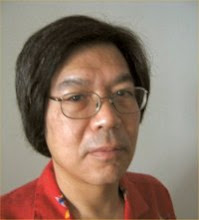I had to get rid of some of the files on the disc i used to save the CineVue obit on Edward Yang: it was getting too crowded. So i looked through a number of the files, and erased some of them. (The ones i erased were articles which are "in print".) I also came across several articles-in-progress, and i do want to finish them....
I also came across a short item that i had hoped to use on this blog. It was from last summer, and was about the MIT List Visual Art Center's exhibition on "9 Evenings Reconsidered: Art, Theatre, and Engineering, 1966". According to the press release we received, Catherine Morris was the curator, and she is putting together a book, going through the files of E.A.T. (Initially, the person who was the archivist for "9 Evenings" was (i believe) Simone Forti.) I noted that it's another example (as are the docs "Jack Smith and the Destruction of Atlantis" and "Notes on Marie Menken" and Callie Angell's book on Andy Warhol) of this... Memorializing of the 1960s? Fetishizing of the 1960s? In most cases, the people who are doing the "recreation" weren't around to have experienced the events/people firsthand. Of course, why should it matter? Did Leon Edel ever meet Henry James? But the problem is that the period of New York City and the arts in the 1950s and 1960s has become historical, yet it's still so recent and so near-present, and we have learned so much about the distortions of history, about what gets remembered and what is not, and how the victors write the history....
And i mention this because the "point" of "Jack Smith and the Destruction of Atlantis" and "Notes on Marie Menken" is that these are artists who have been "forgotten" while the victor (historically) has been Andy Warhol. He has come to be the artist who has defined success in the 1960s, and Jack and Marie (both of whom were very influential on Warhol, and both of whom started their careers in the 1950s, well before Warhol decided to try his hand at "art") have been regulated to the "background" of the period.
Of course, this is not fair because Jack and Marie were important artists in their own right. Yet Jack and Marie are finding defenders (actually, Jack always had defenders, all his life; i know, i was one of the many), but there remain other artists who are forgotten. Jerry Jofen, whose strange hermitic presence complemented Jack's in the work of Ken Jacobs's, and whose own films were exceptionally delicate. Or Storm De Hirsch, another vital woman filmmaker of the 1950s and 1960s.
And i bring up Carolyn Brown's discussion of "9 Evenings" in her book "Chance and Circumstance": as a witness, what she saw was basically a disaster. And as a spectator, what i saw was basically a disaster! So i can't understand what people are doing, pumping up this event as a watershed, when it was really a low point for almost everyone. (And Yvonne Rainer, in her memoir, "Feelings Are Facts", describes her event as a monumental disaster.) So it makes me crazy: i was there, and i can tell you, it wasn't good. And people who aren't enamoured of the "glamour" of all those "names" (Rauschenberg, Rainer, Paxton, Childs, et al), including many of the participants themselves, if they're honest, also will tell you it was NG (not good).
There's so much that i remember, and yet... it's like with a lot of the dance i saw in the 1960s and 1970s: was it good? Or was it just different? And because it was different, since i was (from the earliest time i can remember) always someone with an "avantgarde" sensibility, did i like the difference simply for its own sake? It's hard for me to say.


0 Comments:
Post a Comment
<< Home